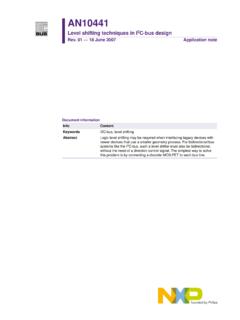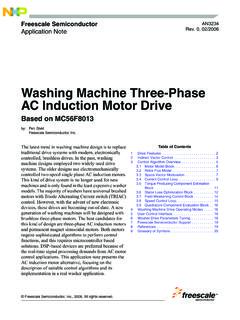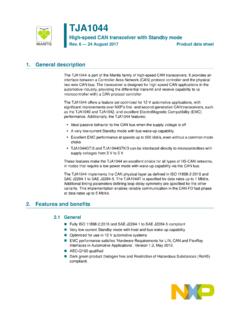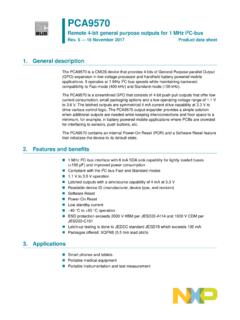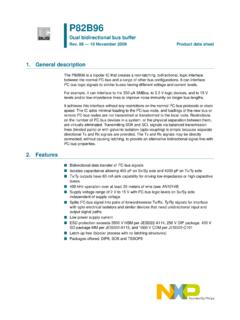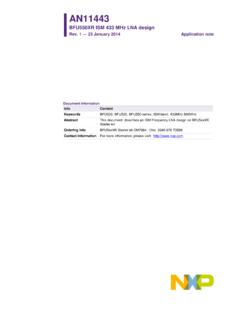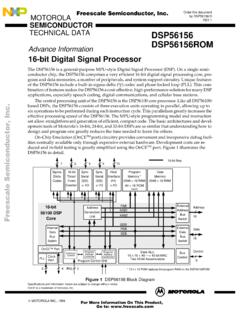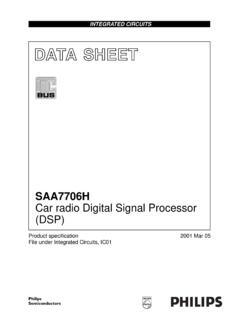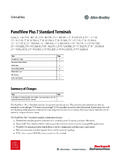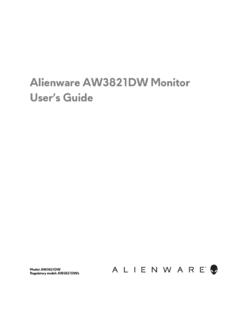Transcription of LPC546xx Product data sheet
1 1. General descriptionThe LPC546xx is a family of ARM Cortex-M4 based microcontrollers for embedded applications featuring a rich peripheral set with very low power consumption and enhanced debug features. The ARM Cortex-M4 is a 32-bit core that offers system enhancements such as low power consumption, enhanced debug features, and a high level of support block integration. The ARM Cortex-M4 CPU incorporates a 3-stage pipeline, uses a Harvard architecture with separate local instruction and data buses as well as a third bus for peripherals, and includes an internal prefetch unit that supports speculative branching. The ARM Cortex-M4 supports single-cycle digital signal processing and SIMD instructions. A hardware floating-point processor is integrated into the core. The LPC546xx family includes up to 512 KB of flash, 200 KB of on-chip SRAM, up to 16 kB of EEPROM memory, a quad SPI Flash Interface (SPIFI) for expanding program memory, one high-speed and one full-speed USB host and device controller, Ethernet AVB, LCD controller, Smart Card Interfaces, SD/MMC, CAN FD, an External Memory Controller (EMC), a DMIC subsystem with PDM microphone interface and I2S, five general-purpose timers, SCTimer/PWM, RTC/alarm timer, Multi-Rate Timer (MRT), a Windowed Watchdog Timer (WWDT), ten flexible serial communication peripherals (USART, SPI, I2S, I2C interface), Secure Hash Algorithm (SHA), 12-bit Msamples/sec ADC, and a temperature Features and benefits ARM Cortex-M4 core (version r0p1): ARM Cortex-M4 processor, running at a frequency of up to 220 MHz.
2 The LPC5460x/61x devices operate at CPU frequencies of up to 180 MHz. The LPC54628 device operates at CPU frequencies of up to 220 MHz. Floating Point Unit (FPU) and Memory Protection Unit (MPU). ARM Cortex-M4 built-in Nested Vectored Interrupt Controller (NVIC). Non-maskable Interrupt (NMI) input with a selection of sources. Serial Wire Debug (SWD) with six instruction breakpoints, two literal comparators, and four watch points. Includes Serial Wire Output and ETM Trace for enhanced debug capabilities, and a debug timestamp counter. System tick ARM Cortex-M4 microcontroller; up to 512 KB flash and 200 kB SRAM; High-speed USB device/host + PHY; Full-speed USB device/host; Ethernet AVB; LCD; EMC; SPIFI; CAN FD, SDIO; SHA; 12-bit 5 Msamples/s ADC; DMIC subsystem Rev. 8 September 2020 Product data sheetLPC546xxAll information provided in this document is subject to legal disclaimers. NXP Semiconductors 2020. All rights data sheetRev. 8 September 2020 2 of 171 NXP SemiconductorsLPC546xx32-bit ARM Cortex-M4 microcontroller On-chip memory: Up to 512 KB on-chip flash program memory with flash accelerator and 256 byte page erase and write.
3 Up to 200 KB total SRAM consisting of 160 KB contiguous main SRAM and an additional 32 KB SRAM on the I&D buses. 8 KB of SRAM bank intended for USB traffic. 16 KB of EEPROM. ROM API support: Flash In-Application Programming (IAP) and In-System Programming (ISP). ROM-based USB drivers (HID, CDC, MSC, and DFU). Flash updates via USB. Booting from valid user code in flash, USART, SPI, and I2C. Legacy, Single, and Dual image boot. OTP API for programming OTP memory. Random Number Generator (RNG) API. Serial interfaces: Flexcomm Interface contains up to ten serial peripherals. Each Flexcomm Interface can be selected by software to be a USART, SPI, or I2C interface. Two Flexcomm Interfaces also include an I2S interface. Each Flexcomm Interface includes a FIFO that supports USART, SPI, and I2S if supported by that Flexcomm Interface. A variety of clocking options are available to each Flexcomm Interface and include a shared fractional baud-rate generator. I2C-bus interfaces support Fast-mode and Fast-mode Plus with data rates of up to 1 Mbit/s and with multiple address recognition and monitor mode.
4 Two sets of true I2C pads also support High Speed Mode ( Mbit/s) as a slave. Two ISO 7816 Smart Card Interfaces with DMA support. USB high-speed host/device controller with on-chip high-speed PHY. USB full-speed host/device controller with on-chip PHY and dedicated DMA controller supporting crystal-less operation in device mode using software library. See Technical note TN00032 for more details. SPIFI with XIP feature uses up to four data lines to access off-chip SPI/DSPI/QSPI flash memory at a much higher rate than standard SPI or SSP interfaces. Ethernet MAC with MII/RMII interface with Audio Video Bridging (AVB) support and dedicated DMA controller. Two CAN FD modules with dedicated DMA controller. Digital peripherals: DMA controller with 30 channels and up to 24 programmable triggers, able to access all memories and DMA-capable peripherals. LCD Controller supporting both Super-Twisted Nematic (STN) and thin - film transistor (TFT) displays. It has a dedicated DMA controller, selectable display resolution (up to 1024 x 768 pixels), and supports up to 24-bit true- color mode.
5 External Memory Controller (EMC) provides support for asynchronous static memory devices such as RAM, ROM and flash, in addition to dynamic memories such as single data rate SDRAM with an SDRAM clock of up to 100 MHz. EMC bus width (bit) on TFBGA180, TFBGA100, and LQFP100 and packages supports up to 8/16 data line wide static memory, in addition to dynamic memories, such as, SDRAM (2 banks only) with an SDRAM clock of up to 100 MHz. Secured digital input/output (SD/MMC and SDIO) card interface with DMA support. LPC546xxAll information provided in this document is subject to legal disclaimers. NXP Semiconductors 2020. All rights data sheetRev. 8 September 2020 3 of 171 NXP SemiconductorsLPC546xx32-bit ARM Cortex-M4 microcontroller CRC engine block can calculate a CRC on supplied data using one of three standard polynomials with DMA support. Up to 171 General-Purpose Input/Output (GPIO) pins. GPIO registers are located on the AHB for fast access. The DMA supports GPIO ports.
6 Up to eight GPIOs can be selected as Pin Interrupts (PINT), triggered by rising,falling or both input edges. Two GPIO Grouped Interrupts (GINT) enable an interrupt based on a logical(AND/OR) combination of input states. CRC engine. Analog peripherals: 12-bit ADC with 12 input channels and with multiple internal and external trigger inputs and sample rates of up to MSamples/sec. The ADC supports two independent conversion sequences. Integrated temperature sensor connected to the ADC. DMIC subsystem including a dual-channel PDM microphone interface, flexible decimators, 16 entry FIFOs, optional DC locking, hardware voice activity detection, and the option to stream the processed output data to I2S. Timers: Five 32-bit general purpose timers/counters, four of which support up to four capture inputs and four compare outputs, PWM mode, and external count input. Specific timer events can be selected to generate DMA requests. The fifth timer does not have external pin connections and may be used for internal timing operations.
7 SCTimer/PWM with 8 input and 10 output functions (including capture and match). Inputs and outputs can be routed to/from external pins and internally to or from selected peripherals. Internally, the SCTimer/PWM supports 10 match/captures, 10 events, and 10 states. 32-bit Real-time clock (RTC) with 1 s resolution running in the always-on power domain. A timer in the RTC can be used for wake-up from all low power modes including deep power-down, with 1 ms resolution. Multiple-channel multi-rate 24-bit timer (MRT) for repetitive interrupt generation at up to four programmable, fixed rates. Windowed Watchdog Timer (WWDT). Repetitive Interrupt Timer (RIT) for debug time stamping and for general purpose use. Security features: enhanced Code Read Protection (eCRP) to protect user code. OTP memory for ECRP settings, and user application specific data. Secure Hash Algorithm (SHA1/SHA2) module with dedicated DMA controller. Clock generation: 12 MHz internal Free Running Oscillator (FRO).
8 This oscillator provides a selectable 48 MHz or 96 MHz output, and a 12 MHz output (divided down from the selected higher frequency) that can be used as a system clock. The FRO is trimmed to 1 % accuracy over the entire voltage and temperature range. External clock input for clock frequencies of up to 25 MHz. Crystal oscillator with an operating range of 1 MHz to 25 information provided in this document is subject to legal disclaimers. NXP Semiconductors 2020. All rights data sheetRev. 8 September 2020 4 of 171 NXP SemiconductorsLPC546xx32-bit ARM Cortex-M4 microcontroller Watchdog Oscillator (WDTOSC) with a frequency range of 6 kHz to MHz. kHz low-power RTC oscillator. System PLL allows CPU operation up to the maximum CPU rate and can run from the main oscillator, the internal FRO, the watchdog oscillator or the KHz RTC oscillator. Two additional PLLs for USB clock and audio subsystem. Independent clocks for the SPIFI interface, ADC, USBs, and the audio subsystem.
9 Clock output function with divider. Frequency measurement unit for measuring the frequency of any on-chip or off-chip clock signal. Power control: Programmable PMU (Power Management Unit) to minimize power consumption and to match requirements at different performance levels. Reduced power modes: sleep, deep-sleep, and deep power-down. Wake-up from deep-sleep modes due to activity on the USART, SPI, and I2C peripherals when operating as slaves. Ultra-low power Micro-tick Timer, running from the Watchdog oscillator that can be used to wake up the device from low power modes. Power-On Reset (POR). Brown-Out Detect (BOD) with separate thresholds for interrupt and forced reset. Single power supply V to V. Power-On Reset (POR). Brown-Out Detect (BOD) with separate thresholds for interrupt and forced reset. JTAG boundary scan supported. 128 bit unique device serial number for identification. Operating temperature range 40 C to +105 C. Available in TFBGA180, TFBGA100, LQFP208, and LQFP100 information provided in this document is subject to legal disclaimers.
10 NXP Semiconductors 2020. All rights data sheetRev. 8 September 2020 5 of 171 NXP SemiconductorsLPC546xx32-bit ARM Cortex-M4 microcontroller3. Ordering information Table information Type numberPackageNameDescriptionVersionLPC54 605J256ET180 TFBGA180 thin fine-pitch ball grid array package; 180 balls; body 12 12 mmSOT570-3 LPC54605J512ET180 TFBGA180 thin fine-pitch ball grid array package; 180 balls; body 12 12 mmSOT570-3 LPC54605J256BD100 LQFP100plastic low profile quad flat package; 100 leads; body 14 14 mmSOT407-1 LPC54605J512BD100 LQFP100plastic low profile quad flat package; 100 leads; body 14 14 mmSOT407-1 LPC54605J256ET100 TFBGA100 plastic thin fine-pitch ball grid array package; 100 balls; body 9 9 mmSOT926-1 LPC54605J512ET100 TFBGA100 plastic thin fine-pitch ball grid array package; 100 balls; body 9 9 mmSOT926-1 LPC54606J256ET100 TFBGA100 plastic thin fine-pitch ball grid array package; 100 balls; body 9 9 mmSOT926-1 LPC54606J256BD100 LQFP100plastic low profile quad flat package; 100 leads.
